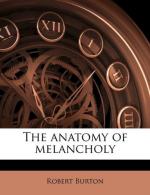SUBSECT. V.—Of the Soul and her Faculties.
According to [967]Aristotle, the soul is defined to be [Greek: entelecheia], perfectio et actus primus corporis organici, vitam habentis in potentia: the perfection or first act of an organical body, having power of life, which most [968]philosophers approve. But many doubts arise about the essence, subject, seat, distinction, and subordinate faculties of it. For the essence and particular knowledge, of all other things it is most hard (be it of man or beast) to discern, as [969]Aristotle himself, [970]Tully, [971]Picus Mirandula, [972]Tolet, and other neoteric philosophers confess:—[973]"We can understand all things by her, but what she is we cannot apprehend.” Some therefore make one soul, divided into three principal faculties; others, three distinct souls. Which question of late hath been much controverted by Picolomineus and Zabarel. [974] Paracelsus will have four souls, adding to the three grand faculties a spiritual soul: which opinion of his, Campanella, in his book de sensu rerum [975]much labours to demonstrate and prove, because carcasses bleed at the sight of the murderer; with many such arguments And [976]some again, one soul of all creatures whatsoever, differing only in organs; and that beasts have reason as well as men, though, for some defect of organs, not in such measure. Others make a doubt whether it be all in all, and all in every part; which is amply discussed in Zabarel amongst the rest. The [977]common division of the soul is into three principal faculties—vegetal, sensitive, and rational, which make three distinct kinds of living creatures—vegetal plants, sensible beasts, rational men. How these three principal faculties are distinguished and connected, Humano ingenio inaccessum videtur, is beyond human capacity, as [978] Taurellus, Philip, Flavins, and others suppose. The inferior may be alone, but the superior cannot subsist without the other; so sensible includes vegetal, rational both; which are contained in it (saith Aristotle) ut trigonus in tetragono as a triangle in a quadrangle.




